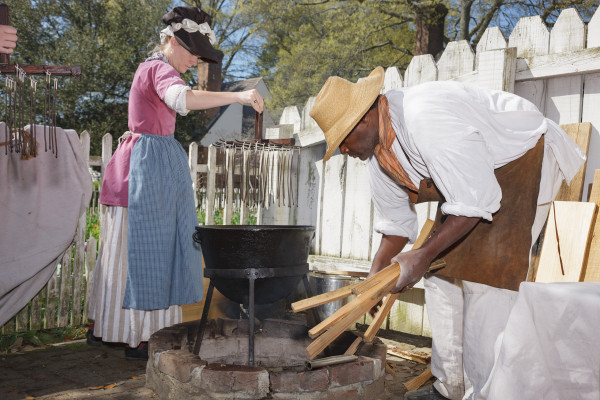
After a decades-long hiatus, candlemaking as a trade has returned to the Revolutionary City. Chandlers, as they are known, are hand-dipping candles and you can join in on the fun.
While some thought candlemaking may not have taken place in Williamsburg in the 18th century, Joe Beatty, Director of Historical Research and Training, says evidence was found in the Virginia Gazette:
“We see evidence in the Virginia Gazette, account books, and tax records of a candle maker in Williamsburg from the mid-1770s through the mid-1780s. This man, named Morto Brien, advertised in July 1776 that ‘he has erected a Manufactory of SOAP and CANDLES in this City, and intends carrying on the Business in the best Manner.’ Mr. Brien (sometimes Bryan) moved to Williamsburg from Norfolk and appears to have continued his candle making business at least through the end of Revolution, if not longer.”
Tom Redd, a Materials Analyst for the Foundation, is heading up the newest (old) trade. You can find the team behind the Joiner Shop. The chandlers are hard at work making candles from three different materials—tallow, beeswax, and bayberry wax, with beeswax and bayberry wax being the two used the most. Tallow (rendered beef, sheep, deer, or bear fat—with beef tallow being more common in Virginia) candles were the cheapest to purchase but wouldn’t last as long as beeswax or bayberry. Tom gave me this great scenario on burn times for the candles:
“Let us imagine we have four candles, and each one is about three-quarters of an inch in diameter and they are all about 10 inches long. They are in a room where the air is still. A candle well-made of the best tallow might burn two hours. A bayberry candle might last eight, while a beeswax candle may burn for 10 hours. The finest candle, imported from New England, would have been made of spermaceti wax. Spermaceti is taken from the head of the sperm whale. The spermaceti candle might last 12 hours or more, and burn with a brighter light.”
When I visited the shop, the chandlers were using beeswax and hand-dipping dozens of candles with a piece of equipment made especially for them by the joiners. Each arm on the “tree” can hold about 50 wicks for dipping, so chandlers aren’t hand-dipping candles one-by-one. This method takes about an hour to complete, with each candle needing anywhere between 50 to 55 dips in the hot wax.
To make candles, chandlers begin by accumulating wax and placing it on a pot. As the wax melts, chandlers set up the rest of the production. Once melted, they begin to dip the wicks into the hot wax. You don’t want the wax to be too hot or too cold—it has to be at a Goldilocks state—so the fire is monitored. The chandlers take one arm at a time over to the pot of melted wax and dip it in up to a certain height of the wick. The arm is placed back on the tree and another chandler takes an arm to the pot. As the layer of wax begins to cool, the chandlers work to make each wick straight. This has the be done in the beginning stages as the candles are more pliable. In turn, each arm is dipped into the wax and after 50 to 55 dips, a completed candle is made. Chandlers then work to make the candles a bit more uniform and they are ready for sale.
Fun fact: Chandlers won’t be able to make candles if the weather isn’t just right, either. It can’t be too windy or rainy. Don’t be discouraged if you come by for a visit and they aren’t making candles; they will teach you everything you need to know about candlemaking and some incredible nuggets of history. They have lots of materials on site to show you as well.
Now, with that said, candles were purchased by the majority of people in the 18th century, but they weren’t necessarily seen as something to be used all of the time. Most went to bed as the sun set and woke up with the sunrise in an effort to utilize as much natural light as possible. Have you ever tried to read by candlelight? It’s not my favorite thing to do because the light isn’t very bright.
Here’s how you can get involved. Guests are invited to dip their own candles with the chandlers and you’ll be able to take home one of your creations. All you need is a special ticket. For more information, click here.
And be sure to like the Historic Trades and Skills Facebook page to keep up with all the fun the chandlers are having. Happy candle-making!
Thank you to Colonial Williamsburg Photographer Darnell Vennie for taking these great photographs!
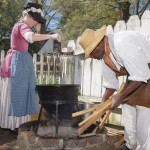
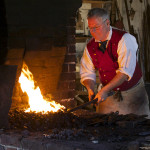
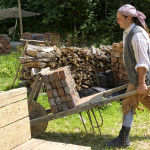
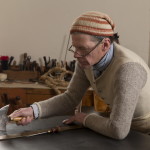
Laura C. says
I still have the hand-dipped candle I made as a child when I visited CW in the 1970s. I was hoping my son would have that opportunity this summer. At least he may get to see the chandlers at work. Welcome back!
According to A NEW AND COMPLETE DICTIONARY OF ARTS and SCIENCES (1763, London), tallow candles are dipped or molded. But wax candles are made “by the ladle”, “by the hand”, or drawn (as wire is made). Do you evidence of wax candles being dipped in the 18th century?
I present an early lighting and candle program for third graders up here in Massachusetts, so I’d like to have accurate information to present to the students.
Thank you!! I hope to come down to see your candle making presentation when I get a chance. Keep up the great work.
Ruth
PS I just wanted to be sure I signed up to receive email notifications of follow-up comments. 🙂
Hi, Rachel: I attended a Williamsburg Institue back in the late 80s or early 90s which was held in the Palace kitchen to learn 18th century candlemaking, which I, in turn used in my candlemaking business here in Michigan.. The interpreter/teacher told us candlemaking was not interpreted in the historic area because researchers had found no evidence (at that time) that candles were made in Williamsburg. Most were made “at home” by slaves and children, or imported, rather than being locally made to be available in shops.
Has new evidence been found to support the trade in the historic area? I am anxious to see the new candlemakers when we come down again.
Great question, Kristina! And that is awesome to hear about your own business! Here’s the skinny from Joe Beatty, our Director of Historical Research:
We see evidence in the Virginia Gazette, account books, and tax records of a candlemaker in Williamsburg from the mid-1770s through the mid-1780s. This man, named Morto Brien, advertised in July 1776 that “he has erected a Manufactory of SOAP and CANDLES in this City, and intends carrying on the Business in the best Manner.” Mr. Brien (sometimes Bryan) moved to Williamsburg from Norfolk and appears to have continued his candle making business at least through the end of Revolution, if not longer.
Awesome. Thanks for the update..
I often cite a piece of info I learned at the Institute. When I do a workshop for school children I tell them children made the candles used throughout the year during the good weather of summer. They think that’s cool until they learn it took about 1,000 candles to get through the year. Suddenly, it never sound like such a great summer-time chore.
When will they close up the candle making season? We will be down for Halloween.
Hi, Danielle!
I wish I could give you a definitive answer, but we don’t have a hard stop right now! As we get through the summer, we’ll see! Keep an eye out and feel free to remind me again as your trip gets closer. We’re looking forward to having you!